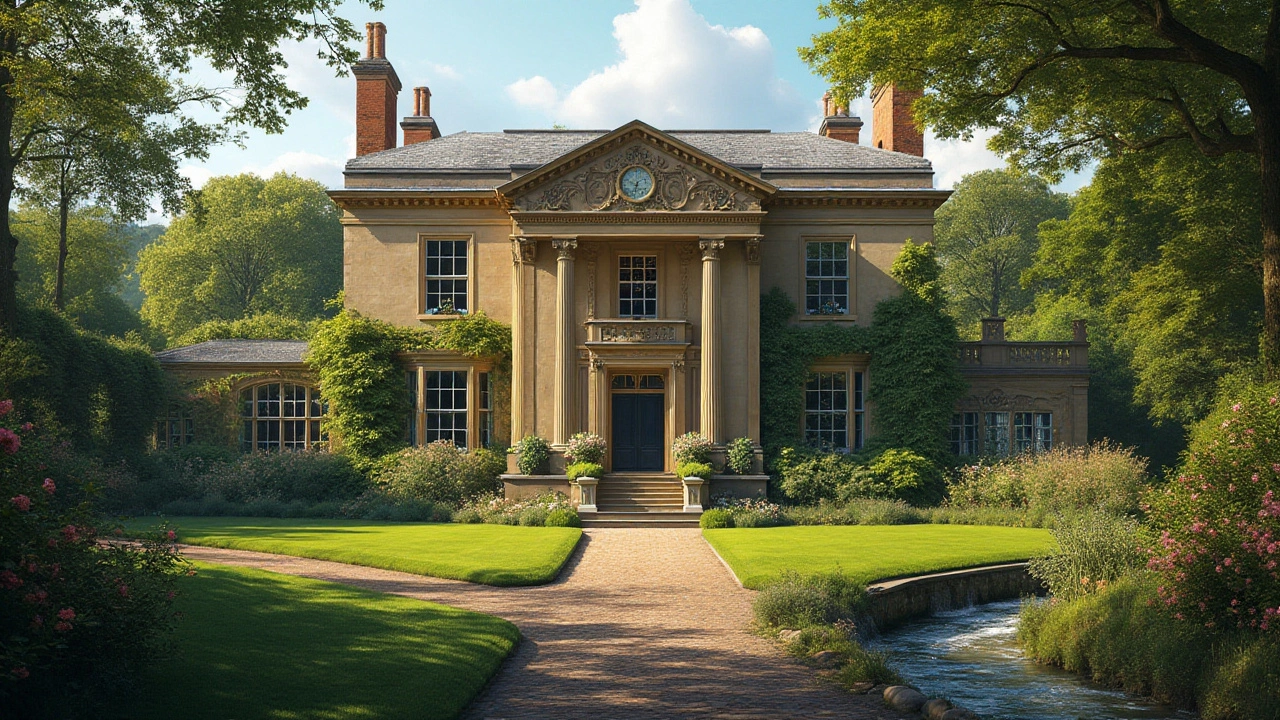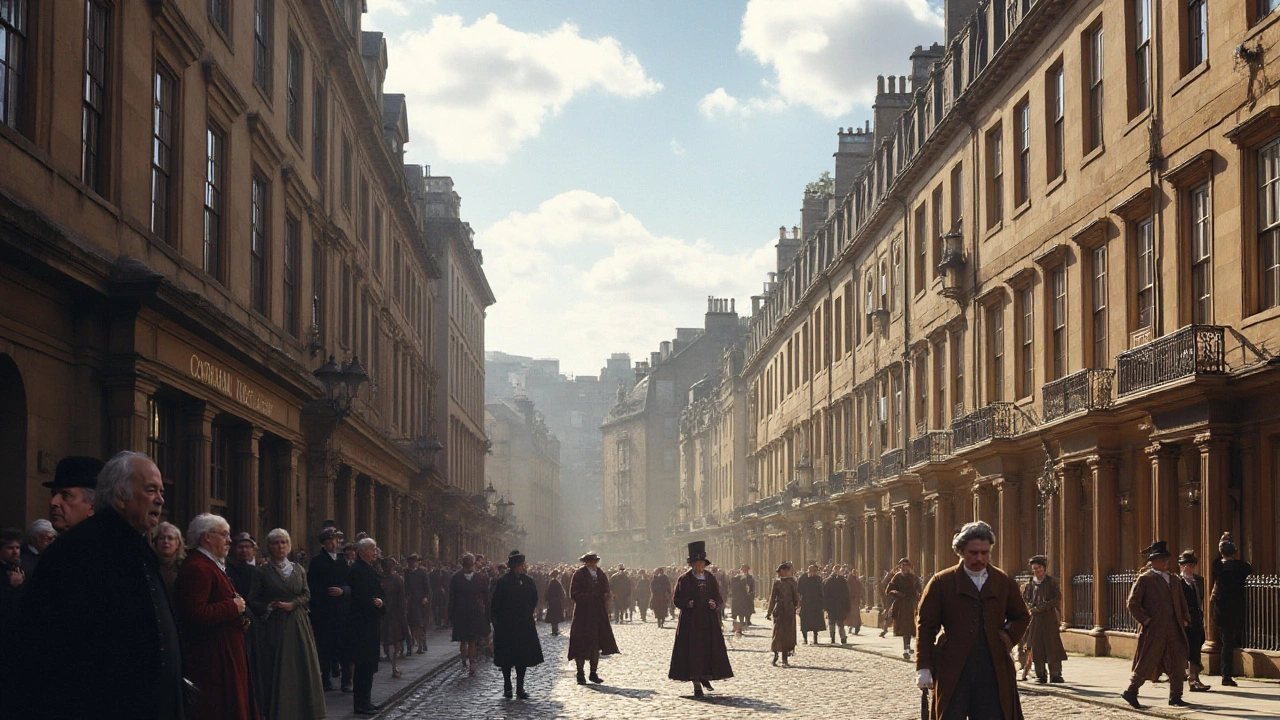Georgian architecture is a testament to an era where symmetry and proportion reigned supreme, bringing order and beauty to buildings that have stood the test of time. This architectural style, which blossomed between 1714 and 1830, was heavily influenced by the classical structures of ancient Rome and Greece. It is not just about the aesthetics; it encapsulates the very cultural essence of a period striving for balance and order in its surroundings.
Embarking on a journey through the world of Georgian architecture means uncovering unique facets of its elegant signature features. From the tall sash windows and intricate cornices to the perfectly balanced façades, each element has a story to tell. These structures, whether found in busy urban landscapes or tranquil countrysides, offer a glimpse into a past that celebrated beauty in every line and curve.
As we delve into this captivating architectural style, we will wander through its rich history, explore distinguished landmarks that exemplify this grand era, and discover how its legacy continues to influence modern design practices today. Whether you're a seasoned architectural enthusiast or a curious beginner, the world of Georgian architecture has something enduringly captivating to offer.
- Origins and Historical Context
- Key Characteristics of Georgian Architecture
- Notable Georgian Buildings Worldwide
- The Influence of Georgian Style in Modern Design
- How to Identify and Appreciate Georgian Architecture
Origins and Historical Context
The story of Georgian architecture begins in the early 18th century, as Great Britain found itself in the throes of the Enlightenment, an era marked by rapid advancements in science, philosophy, and culture. The Georgian period, named after four consecutive British monarchs—George I, II, III, and IV—spanned from 1714 to 1830. During this time, architecture dramatically evolved to reflect the Enlightenment ideals of symmetry, proportion, and order, deeply influenced by classical antiquity. Architects studied the Roman and Greek ruins, gleaning inspiration from these ancient structures to create buildings that were not only beautiful but also practical. The Palladian style, derived from the works of Andrea Palladio, an influential Italian architect from the Renaissance, profoundly impacted the Georgian aesthetic. As the Baroque style of the late 17th century waned, a shift towards simplicity and balance began to take hold, giving birth to a new wave of architectural elegance.
Georgian architecture can be seen as a visual manifestation of the 18th-century mindset, which cherished clarity and reason. This shift was part of a larger movement across Europe, where classical principles were embraced anew. Architectural design during this period placed great emphasis on proportionality, with an absolute adherence to mathematical principles which ensured harmonious facades and interiors. The concept of the 'Golden Ratio', a mathematical ratio often found in nature and art, was key to designing spaces that felt innately pleasing to the eye. This period also saw the rise of urbanization, with a growing middle class seeking residences that mirrored the refined elegance favored by the elite. Georgian homes, characterized by their simplistic grandeur, provided just this. Cities like London, Bath, and Dublin saw the rapid construction of terraced Georgian houses, defined by their uniformity and classic lines, making them an icon of the era's architectural ingenuity.
The ripple effect of Georgian architecture was not confined to the British Isles. As the British Empire expanded, so too did the reach of this refined architectural style. During the 18th century, the colonies in America embraced Georgian architecture, with notable examples evident in grand estates and civic buildings. The style's adaptability made it suitable for urban and rural settings, lending itself to mansions as well as more modest townhouses. In Australia, one can still find splendid examples, such as in Sydney's historic district, where the colonial interpretations of Georgian architecture captured the essential qualities that marked this style as timeless. The driving force behind Georgian architecture was not only aesthetic; it was about creating a built environment that resonated with the ideals of the new, enlightened society: a world of order, reason, and durability.
"Georgian architecture remains a testament to an age of elegance and enlightenment." – John Summerson
Key Characteristics of Georgian Architecture
When it comes to identifying Georgian architecture, there's a harmonious blend of beauty and functionality that sets it apart. This architectural style, deeply rooted in the principles of order and symmetry drawn from classical antiquity, crafted a signature look that continues to captivate. A key characteristic is its emphasis on proportion, with building dimensions often influenced by the golden ratio, giving each structure a balanced and aesthetically pleasing appearance. Rectangular and square shapes dominate the design, with facades that revel in simplicity yet exude an air of grandeur. Windows are a prominent feature, typically sash-type with six or more panes per window, and they are meticulously aligned both vertically and horizontally.
The Georgian approach to design didn’t stop at exteriors; interior layouts were meticulously planned for both comfort and functional living. Ceilings were often higher on the ground floor, giving the rooms an airy elegance. Fireplaces, essential for heating, were made focal points and sometimes featured ornate mantelpieces. Walls were adorned with intricate moldings, and niches were used to create a sense of depth. To enhance the design, muted tones such as soft blues, warm yellows, and gentle creams were favored, reflecting the elegance and restraint of the era.
A hallmark of Georgian architecture is its decorative elements which, though subtle, offer an understated richness. Cornices and cornicing, often elaborately crafted, add a touch of sophistication to the rooflines and ceilings. Doorways are framed with classical details; the fanlight, a semi-circular window above the door, became a renowned feature, often filled with delicate tracery. Roofs were typically side-gabled or hipped, with the chimneys symmetrically placed to harmonize with the rest of the facade.
"Georgian architecture represents one of those rare moments in history when aesthetics, functionality, and technological innovation converged in perfect harmony," commented Sir John Summerson, a revered architectural historian, underscoring the timeless appeal of this style.
Also worth noting are the materials that define this architectural genre. Brick, often red or brown, is the primary material and represents the Georgian preference for natural, robust construction materials. Stone accents and stucco finishes can also be found, particularly in grander buildings, which blend elegance with resilience. The aim was to exude a sense of permanence and solidity, a testament to the authority and stability of the era.
An interesting yet understated feature is the use of mathematical tiles on external walls, particularly in regions prone to harsh weather. These tiles mimic the appearance of brickwork and were used to add a protective layer against the elements, showing the blend of practicality and aesthetic concern that defines the Georgian style. Perhaps it's this unification of attractive design, historical context, and enduring build quality that grants these structures their lasting legacy in the world of architecture.

Notable Georgian Buildings Worldwide
Georgian architecture stands as a proud witness to a time when elegance and precision were crafted into the very foundations of buildings. One cannot journey through this architectural era without marveling at the jewel in its crown, the grand rural estates and stately homes composed of perfect symmetry and fine detail. Take, for instance, the magnificent Blenheim Palace in Oxfordshire, a UNESCO World Heritage Site. It's not a pure Georgian masterpiece but its early 18th-century roots display the transition into Georgian style with finesse. Georgian architecture is embodied through its balanced facade and grand stature, making it a destination for thousands who seek to relive the glamour of that epoch.
Across the ocean, the charm of Georgian architecture found a welcoming home in the burgeoning cities of Colonial America. Examples like the Governor's Palace in Williamsburg showcase the style's arrival in the New World. The palace beautifully illustrates how historical buildings adapted to include local materials and climate considerations, yet they remained true to the spirit of Georgian design. Not only did these buildings serve civic and residential purposes, but they also embodied a silent communication of power and elegance to the beholders of their time.
In Ireland, Dublin boasts some of the most splendid surviving examples. Merrion Square, with its red brick row houses, presents an enduring image of Georgian splendor. This iconic area whispers stories of literary giants and political figures who once traversed its streets. The use of uniform facades with variations in door colors is a characteristic feature of Georgian architecture that continues to enthrall architects and tourists alike.
As noted by famed historian Dan Cruickshank, "The Georgian era was a period of classical elegance, one that reflects both power and grandeur, yet never forgets the importance of harmony with nature."
Though Britain and Ireland are saturated with Georgian gems, the influence didn’t stop there. Over in the Southern Hemisphere, places like Cape Town in South Africa witnessed the rise of Georgian influence amidst its colonial architecture. The Groot Constantia Manor House is a fine example of how the stylistic elements were adapted to local vernaculars and climatic needs. It showcases white-washed exteriors, perfectly proportioned windows, and interiors that echo the principles of Georgian design though infused with local artistry.
Georgian architecture's rich and varied presence across continents illustrates not only its aesthetic appeal but its adaptability and resilience. While today we might perceive these buildings as historical treasures, during their time, they were at the frontier of design. They bridged the architectural divide between utility and art, offering timeless appeal which we still appreciate and admire. Traveling through these buildings worldwide gives us an understanding of the influence that such 'classical architecture' has cemented across decades and miles, truly making it a celebrated global heritage.
The Influence of Georgian Style in Modern Design
The allure of Georgian architecture has transcended centuries, weaving its way into the fabric of modern design with a grace and timeless appeal that resonates even today. Its hallmarks of symmetry, proportion, and understated elegance have a universal charm that continues to inspire architects and designers around the globe. We see echoes of these classic elements in new homes and public buildings, where the past is tenderly blended with the present.
One of the aspects that makes Georgian-style homes so versatile is their ability to adapt to contemporary living without losing their original charm. These buildings often boast large windows that allow natural light to flood the interiors, a feature that aligns perfectly with today's demand for bright, airy spaces. The tasteful decorative elements, such as columns and cornices, are often preserved or replicated, adding character and a touch of history to modern spaces.
In recent years, there has been a resurgence in the desire to incorporate Georgian elements into new builds. Architects may choose to integrate its characteristic brickwork, which not only adds a visual delight but also sustainability, as it's renowned for being energy efficient. Interiors often take cues from the Georgian principle of harmony and balance, creating spaces that are as functional as they are beautiful. Open-plan living areas can seamlessly flow into meticulously designed private quarters, maintaining the Georgian emphasis on proportion.
"Georgian architecture is the pinnacle of proportion and light." - John Simpson, Renowned Architect
Homeowners and designers alike are captivated by the versatility and style that Georgian architecture brings to the table. In areas where historic preservation is key, many new developments aim to mimic Georgian façades to maintain the aesthetic coherence of a neighborhood. Even in contemporary cityscapes, the clean lines and classical motifs can offer a refreshing contrast to modernist architecture.
Moreover, the influence of Georgian architecture extends beyond residential properties. Public and commercial buildings often harness these designs to evoke feelings of stability, prestige, and trustworthiness. This is not surprising, given the way Georgian buildings have long been associated with an image of reliability and dignity. This translation into modern architecture ensures that the Georgian legacy lives on, continuously influencing and enriching urban landscapes across the world.

How to Identify and Appreciate Georgian Architecture
Diving into the world of Georgian architecture is akin to unraveling the threads of an elegant tapestry woven with precision and grace. A careful eye can spot a Georgian building through its characteristic balance and timeless symmetry. One of the hallmarks of this architectural style is its orderly façade, often built with brick or stone, lending it a solid yet graceful demeanor. Large sash windows are common, neatly arranged in rows that speak to an unyielding pursuit of proportion and elegance. These windows are not just about aesthetics; they underscore the era's love for ample natural light while providing sweeping views of the landscape, which were thoroughly revered.
Georgian architecture often features a decorative cornice that crowns the structure, accentuating the roofline with an intricacy that complements the simplicity of the overall design. It is common to find buildings with an understated rectangular or square footprint, occasionally adorned with pilasters that hint at their classical influences. Doors in Georgian architecture are typically grand, with a fanlight above and often flanked by columns, creating an inviting entrance that reflects the refined tastes of the time. The roof, usually hipped or sometimes flat, tends to be understated, drawing attention instead to the harmony and balance of the structure below.
Understanding and appreciating Georgian architecture involves acknowledging the cultural context within which it was conceived. The period was marked by change, with a focus on enlightenment, reason, and a clear return to classical ideals. This is reflected in the design principles of the buildings, which aimed to convey order and reason. The architecture from this era not only serves its function but also stands as a symbol of the age's intellectual pursuits. A quote from architectural historian John Summerson reflects this sentiment eloquently:
Georgian architecture is more than just design; it is the translation of philosophical thought into bricks and mortar.This perspective adds a new layer to our understanding, transforming mere buildings into conversations with the past.
To truly appreciate historical buildings of the Georgian era, one must engage with them fully. Visits to renowned Georgian sites can enrich one's understanding by offering an immersive experience. Observing details like the rusticated stonework on lower levels or the delicate molding inside can deepen this appreciation. Additionally, engaging with guides or historians who specialize in this era can provide broader insights into architectural nuances. For those unable to visit in person, digital archives and virtual tours offer accessible alternatives to explore these magnificent structures. The technological adaptations of modern times allow for a broader global appreciation of what was once the purview of the local gentry alone.
It's important to note the influence of Georgian architecture in today's architectural practices. Modern architects often draw inspiration from this style, incorporating its timeless aesthetic into contemporary design, blending tradition with the needs of the present day. This sustainable amalgamation creates spaces that sit comfortably within both historical and modern contexts, bridging centuries in a single building. Thus, recognizing the traces of Georgian influence today not only pays homage to its enduring legacy but also invites us to think critically about how the elegance of the past can inform the spaces of the future. The interplay of history and modernity in architecture makes the study and appreciation of Georgian style as relevant today as it was centuries ago.





